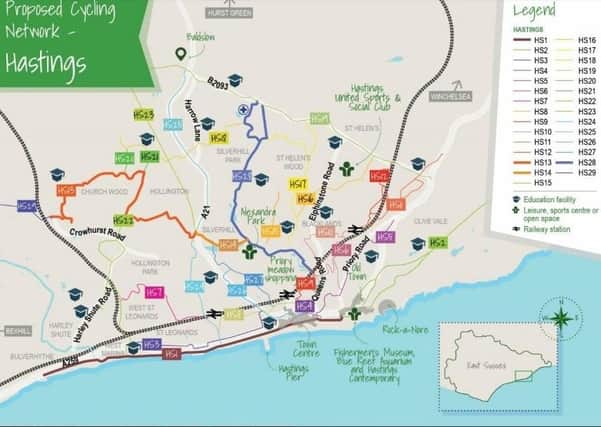Vision for ambitious Hastings cycling and walking network


East Sussex County Council’s is consulting the public on its first local cycling and walking infrastructure plan (LCWIP).
The draft document splits the county up into six areas: Eastbourne and South Downs (including Hailsham and Polegate), Hastings and Bexhill, Newhaven area (including Peacehaven and Seaford), Lewes and South Downs, rural Rother and north Wealden & north Lewes (including Uckfield, Heathfield and Crowborough).
Advertisement
Hide AdAdvertisement
Hide AdProposed cycle network maps have been produced for each of the areas as well as walking network maps for Newhaven, Lewes, Eastbourne, Hailsham, Bexhill and Hastings.
Alongside this is a programme of cycling and walking infrastructure improvements.
These do not contain detailed proposals, but indicate potential alignments of routes or measures, with an emphasis on demonstrating how they can connect with places people may travel for everyday journeys.
The LCWIP ‘sets out an ambitious network of additional cycling and walking routes and measures integrated with existing cycling and walking infrastructure’.
Advertisement
Hide AdAdvertisement
Hide AdIt adds: “This is set alongside the wider transport network, with the aim to maximise the potential to support new housing and employment space coming forward. This first version of the LCWIP will be focussed on those areas where there are the greatest opportunities to increase levels of cycling and walking.”
In Hastings and Bexhill, the plan says: “With existing links in place connecting Bexhill & Hastings to the north and south, the focus of the preferred routes will be on supporting access to local services. Whilst the topography is challenging, especially in some areas of Hastings, there will be an emphasis on supporting wider projects that aid regeneration, including growth in housing and employment and supporting the visitor economy.”
The proposed Hastings cycling network (strategic routes are in bold) includes: HS1 NCN2 Bulverhythe – Old Town, HS2 NCN2 Bulverhythe - Fairlight, HS3 Robertson Street – Wellington Place, HS4 West Hill, HS5 Hastings Station – St Helens Road, HS6 St Helens Road – Ore Road, HS7 Ore Station – The Ridge, HS8 Ore Station – The Ridge (Alternative), HS9 Robsack Wood - Hastings, HS10 Silverhill – Alexandra Park, HS11 The Ridge, HS12 Wishing Tree Road – NCN2, HS13 Battle Road - Silverhill, HS14 Silverhill – St Leonards – NCN2, HS15 A21 – The Ridgeway - Silverhill, HS16 A21 – Silverhill – Hastings Station, HS17 Conquest Hospital – Alexandra Park – Bethune Way, HS18 West St Leonards – A21, HS19 Hughenden Road – Queens Road, HS20 West St Leonards – London Road, HS21 St Leonards Warrior Square – Hastings Centre, HS22 Ashford Road, HS23 St Helens Park Road , HS24 St Helens Park Road , HS25 Tilekin – Conquest Hospital, HS26 Tile Barn Road Spur, HS27 Wishing Tree Road Sur, HS28 Briscoes WalkFriday Street – Pennine Way – Seafront and BHG Bexhill – Hastings Greenway (Combe Valley Way) Friday Street – Pennine Way – Seafront.
The delivery of the plan will rely on the county council and its partners securing external funding and buildings on £23million already secured since 2014 to deliver active travel measures through the local transport capital programme.
Advertisement
Hide AdAdvertisement
Hide AdClaire Dowling, lead member for transport and environment, said: “Walking and cycling not only improves people’s health and wellbeing, it can help protect the environment and improve air quality.
“Some people have been able to re-think how they travel since the beginning of the Covid-19 pandemic with cycling and walking becoming more of an option. We are keen to put in place infrastructure to support the opportunity to change habits and enable others to find more active and healthy ways to travel.”
In line with guidance from the Department for Transport, the county’s first plan will focus on areas where there is the greatest opportunity to increase levels of cycling and walking and therefore, to attract external funding – this includes the coastal strip and larger market towns in the county.
In rural areas, the council will look at how walking and cycling can be supported through its local transport plan, as well as local and neighbourhood plans. Officers will continue to work with local partners to identify opportunities and funding for active travel.
Advertisement
Hide AdAdvertisement
Hide AdCllr Dowling added: “It’s vital that people take this opportunity to comment and help us create a plan that supports active travel and understands the needs of local communities.”
The consultation runs until Friday December 11 and all responses will be carefully considered before a final version of the plan is agreed.
To find out more about the plan and to take part in the consultation, visit the website.